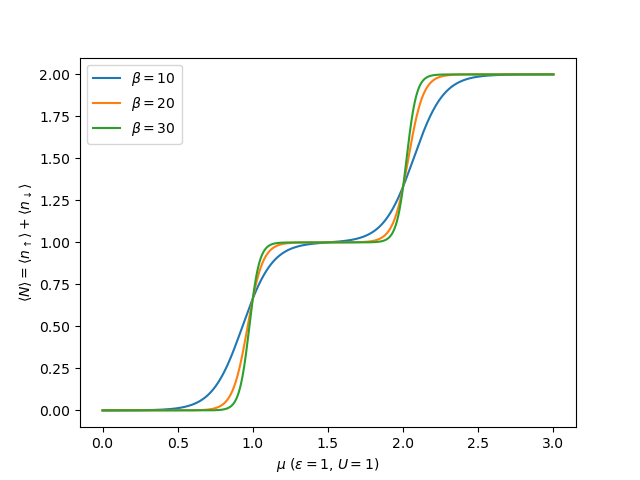Note
Click here to download the full example code
Some Quantum Mechanics, filling an atomic orbital¶
Considering an atomic single orbital and how to fill it by use of the chemical potential. This system has a four element basis, \(B = \{ \lvert \emptyset \rangle, \lvert \uparrow \rangle, \lvert \downarrow \rangle, \lvert \uparrow\downarrow \rangle \}\), that is the empty orbital, one spin up electron, one spin down electron and the filled orbital.
The environment of the orbital is set up by an energy cost for occupying the orbital, that is \(\epsilon\) and when both electrons meet a contact interaction corresponding to the Coulomb repulsion \(U\). Finally the chemical potential \(\mu\) is what allows in the Grand canonical picture, to fill up our atomic orbital from a reservoir of electrons.
The the simple Hamiltonian to model this system is given by:
Here \(c^\dagger,c\) creation and annihilation operators, \(n=c^\dagger c\), and \(\hat{N}=n_\uparrow+n_\downarrow\). This Hamiltonian is diagonal in the basis of particle number we have chosen earlier, as the basis elements are also eigenvectors.
It is easy to see, that the system will prefer to be empty if \(\mu \in [0,\epsilon)\), be single occupied if \(\mu \in (\epsilon, \epsilon +U)\) and doubly occupied if \(\mu > \epsilon +U\).
For a more rigorous treatment, the partition function has to be calculated and then the expected particle number can be found. Introducing a new variable \(\xi = \epsilon - \mu\), and \(\beta\) corresponding to the inverse temperature of the system.
# Code source: Óscar Nájera
# License: BSD 3 clause
import matplotlib.pyplot as plt
import numpy as np
mu = np.linspace(0, 3, 800)
for b in [10, 20, 30]:
n = 2 * (np.exp(b * (mu - 1)) + np.exp(b * (2 * mu - 3))) / \
(1 + np.exp(b * (mu - 1)) * (2 + np.exp(b * (mu - 2))))
plt.plot(mu, n, label=r"$\beta={0}$".format(b))
plt.xlabel(r'$\mu$ ($\epsilon=1$, $U=1$)')
plt.ylabel(r'$\langle N \rangle=\langle n_\uparrow \rangle+\langle n_\downarrow\rangle$')
plt.legend(loc=0)
plt.show()

test
print("lipai's notebook")
Out:
lipai's notebook
Total running time of the script: ( 0 minutes 0.141 seconds)